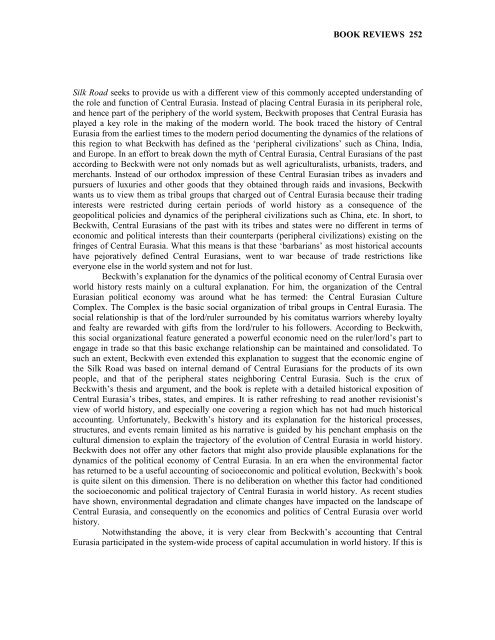Entire Volume 17 issue 1 - Journal of World-Systems Research ...
Entire Volume 17 issue 1 - Journal of World-Systems Research ...
Entire Volume 17 issue 1 - Journal of World-Systems Research ...
You also want an ePaper? Increase the reach of your titles
YUMPU automatically turns print PDFs into web optimized ePapers that Google loves.
BOOK REVIEWS 252<br />
Silk Road seeks to provide us with a different view <strong>of</strong> this commonly accepted understanding <strong>of</strong><br />
the role and function <strong>of</strong> Central Eurasia. Instead <strong>of</strong> placing Central Eurasia in its peripheral role,<br />
and hence part <strong>of</strong> the periphery <strong>of</strong> the world system, Beckwith proposes that Central Eurasia has<br />
played a key role in the making <strong>of</strong> the modern world. The book traced the history <strong>of</strong> Central<br />
Eurasia from the earliest times to the modern period documenting the dynamics <strong>of</strong> the relations <strong>of</strong><br />
this region to what Beckwith has defined as the ‘peripheral civilizations’ such as China, India,<br />
and Europe. In an effort to break down the myth <strong>of</strong> Central Eurasia, Central Eurasians <strong>of</strong> the past<br />
according to Beckwith were not only nomads but as well agriculturalists, urbanists, traders, and<br />
merchants. Instead <strong>of</strong> our orthodox impression <strong>of</strong> these Central Eurasian tribes as invaders and<br />
pursuers <strong>of</strong> luxuries and other goods that they obtained through raids and invasions, Beckwith<br />
wants us to view them as tribal groups that charged out <strong>of</strong> Central Eurasia because their trading<br />
interests were restricted during certain periods <strong>of</strong> world history as a consequence <strong>of</strong> the<br />
geopolitical policies and dynamics <strong>of</strong> the peripheral civilizations such as China, etc. In short, to<br />
Beckwith, Central Eurasians <strong>of</strong> the past with its tribes and states were no different in terms <strong>of</strong><br />
economic and political interests than their counterparts (peripheral civilizations) existing on the<br />
fringes <strong>of</strong> Central Eurasia. What this means is that these ‘barbarians’ as most historical accounts<br />
have pejoratively defined Central Eurasians, went to war because <strong>of</strong> trade restrictions like<br />
everyone else in the world system and not for lust.<br />
Beckwith’s explanation for the dynamics <strong>of</strong> the political economy <strong>of</strong> Central Eurasia over<br />
world history rests mainly on a cultural explanation. For him, the organization <strong>of</strong> the Central<br />
Eurasian political economy was around what he has termed: the Central Eurasian Culture<br />
Complex. The Complex is the basic social organization <strong>of</strong> tribal groups in Central Eurasia. The<br />
social relationship is that <strong>of</strong> the lord/ruler surrounded by his comitatus warriors whereby loyalty<br />
and fealty are rewarded with gifts from the lord/ruler to his followers. According to Beckwith,<br />
this social organizational feature generated a powerful economic need on the ruler/lord’s part to<br />
engage in trade so that this basic exchange relationship can be maintained and consolidated. To<br />
such an extent, Beckwith even extended this explanation to suggest that the economic engine <strong>of</strong><br />
the Silk Road was based on internal demand <strong>of</strong> Central Eurasians for the products <strong>of</strong> its own<br />
people, and that <strong>of</strong> the peripheral states neighboring Central Eurasia. Such is the crux <strong>of</strong><br />
Beckwith’s thesis and argument, and the book is replete with a detailed historical exposition <strong>of</strong><br />
Central Eurasia’s tribes, states, and empires. It is rather refreshing to read another revisionist’s<br />
view <strong>of</strong> world history, and especially one covering a region which has not had much historical<br />
accounting. Unfortunately, Beckwith’s history and its explanation for the historical processes,<br />
structures, and events remain limited as his narrative is guided by his penchant emphasis on the<br />
cultural dimension to explain the trajectory <strong>of</strong> the evolution <strong>of</strong> Central Eurasia in world history.<br />
Beckwith does not <strong>of</strong>fer any other factors that might also provide plausible explanations for the<br />
dynamics <strong>of</strong> the political economy <strong>of</strong> Central Eurasia. In an era when the environmental factor<br />
has returned to be a useful accounting <strong>of</strong> socioeconomic and political evolution, Beckwith’s book<br />
is quite silent on this dimension. There is no deliberation on whether this factor had conditioned<br />
the socioeconomic and political trajectory <strong>of</strong> Central Eurasia in world history. As recent studies<br />
have shown, environmental degradation and climate changes have impacted on the landscape <strong>of</strong><br />
Central Eurasia, and consequently on the economics and politics <strong>of</strong> Central Eurasia over world<br />
history.<br />
Notwithstanding the above, it is very clear from Beckwith’s accounting that Central<br />
Eurasia participated in the system-wide process <strong>of</strong> capital accumulation in world history. If this is





